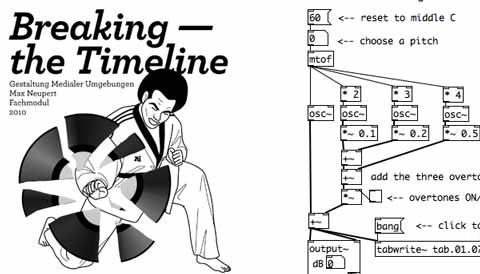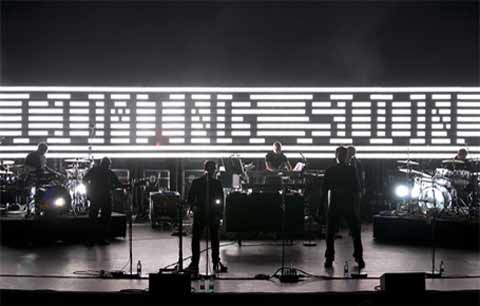Extravagant lighting and video productions are increasingly expected with touring acts, but a little thoughtfulness can go a long way.
Massive Attack @ Myer Music Bowl, Melbourne
Enhancing Massive Attack’s recent sublime musical performances during their Australian Tour, was a very elegantly integrated lighting show designed by United Visual Artists. The kind of gorgeous, restrained and stylised light show you’d hope to see while visiting Blade Runner Town. The lighting set-up was deceptively simple – over the course of the evening, every one of the limited parameters available was gradually tweaked, revealing further variation where it seemed all avenues had been explored. Pulsing dots, became horizontal lines, and then combinations of dots and horizontal lines. From the palette of mostly white, red was sporadically and only very occasionally introduced, and very effectively. Occasional smoke bursts and white lights to reveal on stage depth behind the main plane of pulsing lights. And gradually, the dots are clustered closer, so we can approach something like ascii video playing through the spread out LED wall. Cycling through ascii characters, cleverly varying font sizes and cycling methods to effect the overall image. And again, occasionally using red as individual spotlights. While lighting rigs and lighting pre-visualisation and sequencing tools are getting increasingly sophisticated ( ie crazy ), this show worked because of the restraint shown, its thoughtful choreography and pacing over the evening, and because of its tight integration with the music ( they nearly became inseparable at some points ).
Chris Cunningham’s new Audiovisual Show
This is an exciting prospect. News that one of the most acclaimed music video directors of the last decade, is working on a 75 minute live audiovisual show certainly presses buttons.
“It’s a work in progress really. It’s three giant screens, lasers and a soundtrack that will be like a big mixtape. It’s the closest I can get to what I want to do: the visceral sound of a live show but with massive screens like a cinema,” he explained in the Guardian recently, arguing, “what I do is more experimental and the visuals usually come first. That’s why the live performance is exciting. It’s not film, it’s not a gig, it’s not an installation, but it has elements of all three.”
While it’s undoubtedly an impressive show ( what a great body of work to play with! ), unfortunately the comments on the Guardian article suggest that the performance seems far from live, a sidestage witness suggesting there wasn’t much meaningful being done by Cunningham on stage, others suggesting it seemed like a linear showreel. On the one hand thats fine, the show is a stepping stone, on the other – it’s a reminder that visual technologies tend to lag behind audio in terms of power ( it’s necessarily more computer intensive to manipulate 1 minute of video than audio ). And no doubt, given that the music world has decades more behind it with manipulating loops sequences and processes, it is likely also advanced more conceptually for dealing with time based media in performances. Looking at how someone like Autechre (touring Australia shortly, and themselves with a fine Cunningham video) approach time and samples, might illuminate other approaches to video than ‘jukebox compilation’.
[[ UPDATE ]] This review sounds a bit more promising. And an amusing anecdote from William Gibson about Chris potentially directing a version of Neuromancer:
“Chris is my own 100 per cent personal choice…My only choice. The only person I’ve met who I thought might have a hope in hell of doing it right. I went back to see him in London just after he’d finished the Bjork video, and I sat on a couch beside this dead sex little Bjork robot, except it was wearing Aphex Twin’s head. We talked.”

Weimar in The House
Max Neupert explores great and granular audiovisual compositions using the free software pure data, and now runs ‘Breaking The Timeline‘, a great course at the Bauhaus University of Weimar, which is dedicated to exploring ‘performative audiovisual artworks and experiments’.
“The third dimension of the moving image is time. Manipulation of the timeline means taking control over the creative potential of this dimension. Editing film or video transforms footage into a movie, thus film and video aren’t necessarily linear, but stay static in their determined timeline. Video made analog real-time effects popular but todays graphics processors in computers make it possible to fully explore the real-time potential of digital image and sound.”
Max also makes available patches which demonstrate audiovisual programming techniques in Pure Data and the Gem library.
And let’s not confuse Max with Max for Live – another exciting Audiovisual prospect – complicated max patches ( including jitter video parameters ), controllable from inside Ableton Live and it’s sophisticated sequencing possibilities.


[…] This post was mentioned on Twitter by jean_poole. jean_poole said: recent writings on Herzog voodoo: http://is.gd/bO1cr + Massive Attack light : http://is.gd/bNVZA […]
Oh, Chris Cunningham is doing a live AV show? *giddy*. Also, Neuromancer? My god.
I’m really look forward to seeing Massive Attack in NYC in may, so Im curious to see if UVAs work is in the state side show. Thanks for the heads up 🙂
Hi Vade –
yeah it’s really hard not to be super-curious about what a live Cunningham would be like…
The Neuromancer film doesn’t seem likely to happen though – but I thought that anecdote was funny.
And yes, catch Massive Attack. Really great show, really great catalogue of tracks, and quite a special atmosphere they manage to sustain til the close…
I miss their show here on our city when they came here. So stupid of me that I forgot the big date.